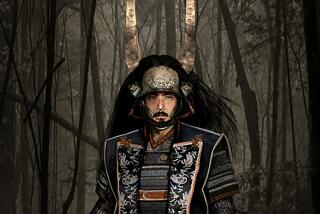WAR HELMETS: MAD HATTERS OF JAPAN
- Share via
SAN FRANCISCO — The history of art has yielded a tiny handful of artists whose longevity or wisdom allowed them to look sublimity in one eye and horror in the other and blink at neither--Titian, Goya, Monet.
Recently, the film maker Akira Kurosawa joined this awesome company with his film “Ran.” A three-hour epic based on Shakespeare’s “King Lear,” it is an old-age masterpiece where disillusionment assumes the dimensions of profundity. Kurosawa directed with a kind of cosmic detachment that is beyond ordinary empathy or morality.
For anyone under the age of 70, the film is almost as frightening in its Olympian distance as it is sumptuous in visual presence. Scene after scene has the cool, spectacular graphic elan of traditional Japanese narrative scrolls but the battle scenes are just as gorgeous as the courtly ones. Soldiers fall in rivers of gore or burn like so much mulberry paper and Kurosawa sees it all like a visual ballet or symphony.
Aestheticized film violence is at least as old as the slow-motion machine-gun scene in “Bonnie and Clyde,” but what makes Kurosawa’s version of it so extraordinary is his lack of relish, cruelty, or bitterness. This film was sent back from the other side and it says something about both Kurosawa’s particular genius and the historical sensibility of Japanese art. It tells us again and again that when there is nothing left to believe in it must still be admitted that life is a riveting extravaganza of folly.
Anyone inclined to doubt this proposition--or agree with it for that matter--must mush right up here to the Asian Art Museum and see “Spectacular Helmets of Japan” before its final day next Sunday. If that proves impossible, get your hands on the catalogue. It illustrates the matter at hand, 75 of the gol-dangedest battle helmets in the entire history of man. For sheer display they make King Arthur’s knights look austere, and for bellicose menace they make a pussycat out of Darth Vader.
It happened thus: 16th-Century Japan was fragmented into territories ruled by independent warlords who murdered and wrangled constantly for the advantage of their clan. Nobody knows exactly why, but during this chaotic epoch a fashion developed for leaders and officers to wear incredibly elaborate battle helmets fashioned of a basic iron cap overlaid with lacquered leather, wood, metal and whatever. They are said to have been inspired by European models during contact with the Dutch, Portuguese and Spanish explorers, but with Japan’s typical genius for absorption and transformation they became as different as sushi is from fish and chips.
When the Edo Shogunate finally re-established central control late in the century, sumptuary laws were passed so that costume would identify people as to class and status and nobody would get too uppity. Thus these helmets--called kawari kabuto --vanished into a unique memento of a legendary epoch.
If ever an exhibition justified itself on pure gee-whiz-golly lines, this is the one. One helmet is a startlingly realistic depiction of a bear’s head covered in real fur. If veracity is not enough, consider that the creature’s ears are of gold. Then there is the snarling head of a deity, the casque sprouting crab claws, the antlers with the three-foot spread or the two-foot tall fishtail covered in peacock feathers. Nobody needed elevator shoes in these rigs.
But you find it all too literal, whimsical or even a bit foppish? Well, nobody ever denied that major macho was without its dollop of narcissism. But if fighting gear is supposed to be sinister even when ceremonial, behold the red lacquered job bristling with horns and a mythical lion. The face-plate looks as if it’s about to eat its grandma. Modern art lovers will vibrate to the lean sculptural streamlining of black helmets with Art Deco loops. If you put this whole collection on the actors in a Steven Spielberg science-fiction epic, no sour anachronism would sound.
Quite impressive enough in themselves, these helmets are just as absorbing for underlying layers of meaning, some universal. Scholars keep fussing about their function, since they didn’t actually provide much shelter from a good swipe with a samurai sword. They may have been developed to identify leaders in battles so huge some actually involved armies of 150,000. Maybe they were meant to intimidate and impress the enemy or act magically to transform the wearer into a living embodiment of the brave or wily creatures of their motifs. (It seems perfectly natural that soldiers would so often select symbols of survival like rabbits or the god of longevity.)
All of the above was undoubtedly part of it. Even more basic, however, is humankind’s universal involvement with our head as the seat of power and will. In every language I know of, head is synonymous with leader . Somehow, it is risible to hear a German call the boss Herr Kopf , but it would be a topsy-turvy world in which we were called to the front office to be chewed out by The Foot. Helmets protect the actual brain porridge but all manner of decorative headgear enhances and protects the ego.
In fact, Kurosawa uses helmets as significant symbols twice in “Ran.” When the duplicitous son kills his brother and annexes his wife, she hands over her dead husband’s helmet to transfer power. When the Lear character is quite bonkers (mad as a hatter?) his Fool gives him a helmet of straw with flowers for horns and we see the state of lyrical innocence brought on by consoling insanity.
Then there is the matter of how inescapably and timelessly Japanese these helmets appear. You can’t look for five minutes without being reminded of those incredibly popular contemporary Japanese toys called Transformers, which are jointed robots that hinge into jet fighters and atomic tanks. They are the precise historical extension of these helmets and exceptional suits of armor that transformed men into robot war machines.
There is something distinctive about Japanese armor, robots and cars that cannot be explained by the usual recourse to their theatricality and admirable sense of design. The clue to it all is probably provided--oddly enough--by the career of Bashford Dean.
Who the blazes is Bashford Dean?
A multilingual genius of a zoologist who founded the Metropolitan Museum’s renowned arms and armor department. He was converted from science to art when he became fascinated by the similarity between the coverings of mollusks and armored fishes and the conception of Japanese armor.
That’s it. Japanese armoring--in whatever form, including auto bodies--has a conceptual basis as a shell and did so long before plastics and sheet metal made such an ideal possible. That’s why even the old stuff looks so modern. Undoubtedly inspired by the creatures of the sea around them, the Japanese ideated armor as a smooth continuous articulated shell. The hoods of these helmets are jointed like lobster tails. Everything about them is made shell-smooth with lacquers that give them a sense of weightlessness and formal continuity that defies historical logic.
What is finally spectacular about these helmets is not their testament to the folly of human ego but their embodiment of its capacity to occasionally give way to a serious insight.
More to Read
The biggest entertainment stories
Get our big stories about Hollywood, film, television, music, arts, culture and more right in your inbox as soon as they publish.
You may occasionally receive promotional content from the Los Angeles Times.










